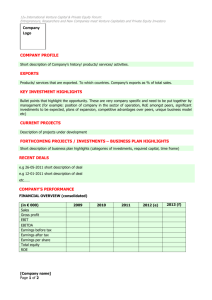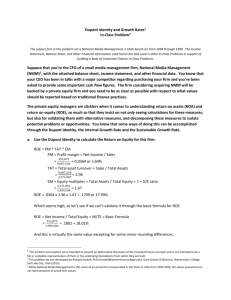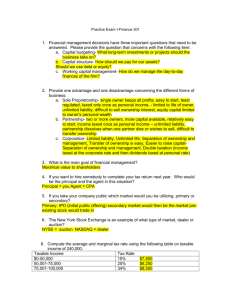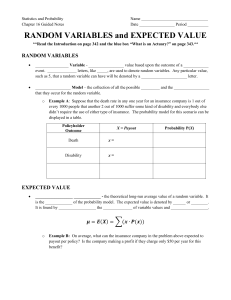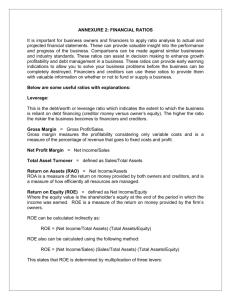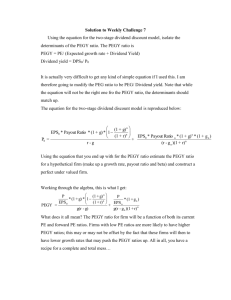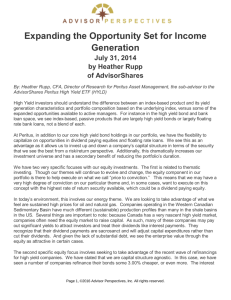Equity Investing: Simple, but not easy
advertisement
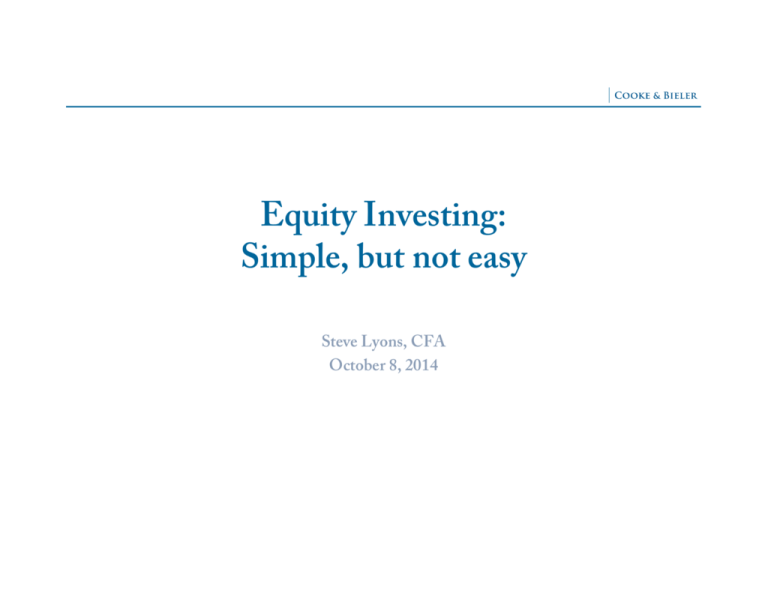
Equity Investing: Simple, but not easy Steve Lyons, CFA October 8, 2014 What does it mean to be an Equity Investor? Own a minority interest in a business Real business / assets / employees / free cash flow FCF / Investment = ROI Similar to a business owner, you are buying a return on your capital when you buy equities FCF / Stock price = your return on capital The price you pay (stock price) is your denominator; it is easily observable Higher stock price = lower return on your capital The numerator, derived from the underlying economics of a business, is less observable This is where Analysts should focus I own a business. What should I care about? Historical price at which you could have sold it? No; previous prices should not influence how attractive a business is today The price you can sell it for today? Maybe, but only if someone else is willing to pay more than it is worth Prudent business owners don’t invest hoping someone else will pay more than it’s worth in the future (greater fool theory) Future free cash flow? Yes; FCF is the fundamental building block that drives what an asset is worth I don’t own a business. What should I care about? Price vs Value Price is what you pay; value is what you get Stock Price Intrinsic Value Opportunity Over the long term stock prices are driven by what you get Returns are governed by the underlying economics of a business; it’s axiomatic over the long term Cash generated by a business can be reinvested or returned to shareholders What drives equity returns? It’s basic arithmetic; there are only three components Earnings growth (driven by reinvestment in the business) Yield (driven by payouts to equity holders) Valuation re-rating / change in trading multiples (one-time change) The longer your time horizon, the less impactful this component becomes Equity Returns Growth in Price Yield reinvest in the business return cash to equity owners recurring Yield = ROE × payout × B/P Earnings Growth Valuation Rerating recurring one-time G = ROE × retention Multiple expansion or contraction Equity Returns Growth in Price Yield reinvest in the business return cash to equity owners recurring Yield = ROE × payout × B/P Earnings Growth Valuation Rerating recurring one-time G = ROE × retention Multiple expansion or contraction Equity Returns Growth in Price Yield reinvest in the business return cash to equity owners recurring Yield = ROE × payout × B/P Earnings Growth Valuation Rerating recurring one-time G = ROE × retention Multiple expansion or contraction Real World Example #1 – The lost decade explained Using the past to gain conviction in the future Base ROE Payout Ratio Beginning Multiple Ending Multiple Total Yield* Earnings Growth Yield + Earnings Growth (Recurring) Impact of Multiple Re-rating 10yr Annualized Total Return 12% 60% 35x 14x 4.3% 4.8% 9.1% -9.6% -0.5% * Total yield includes return generated by assumed net share repurchase and M&A activity. For this exercise I assume a dividend payout ratio of 35% and a M&A/share repo payout ratio of 25%. I also assume all cash returned to shareholders is reinvested in the business. Source: Bloomberg. Example #2: A look forward… Utility Industry ROE – regulated allowed ROEs of ~10% Average payout ratio of ~70% Yield = (ROE * payout ratio) / (P/B) Current utilities trade at ~1.6× P/B (10% ROE * 16× P/E) Yield = (10% * 70%) / (1.6×); low 4’s% Sustainable earnings growth rate is ROE * retention ratio G = 10% * 30%, or ~3% Utility Industry – Expected total return next 10 years ROE Payout Ratio Beginning Multiple Ending Multiple Yield Earnings Growth Yield + Earnings Growth Impact of Multiple (Recurring) Re-rating 10yr Annualized Total Return Bull 10% 70% 16.0x 18.0x 3.9% 3.0% 6.9% +1.3% 8.2% Base 9% 70% 16.0x 14.0x 5.0% 2.7% 7.7% -1.4% 6.3% Bear 8% 70% 16.0x 10.0x 7.0% 2.4% 9.4% -5.0% 4.4% This industry outlook is for illustration purpose only and is not to be considered an official forecast by Cooke & Bieler. Looks simple, but… What I’ve shown you is pretty simple Requires basic algebra Requires a tool kit for accurately assessing the numerator (business fundamentals) Tool kit must include methods to properly assess intrinsic value if current price is attractive Requires discipline and focus to not be led astray As you know… it is not easy. Statistics show that most managers underperform. Many believe it is a bell curve with luck determining the winner. This is a zero-sum game, but statistics speak to correlation… not causation; people confuse the two Top-down statistics ignore fundamentals; actual company economics are what matters Similar to the stock price of a company, short-run performance is fairly random for a manager; over the long run, good managers outperform and they share commonalities Investing is simple… but execution is difficult Behavioral biases Conflicts of interest / Agency costs Behavioral / heuristic hurdles Cognitive dissonance Adaptive bias Anchoring Herd mentality Overconfidence Hindsight bias Social proof Availability bias Confirmation bias Self-serving Recency effect Thesis drift Framing Consistency bias Status quo bias Loss aversion Analysis paralysis Endowment effect Mental accounting Do something syndrome Behavioral biases – Retail Investors Impacts both retail and institutional investors in ways that detract decision making Retail Investors Lack of proper tools to assess value and business fundamentals Decisions made without this knowledge are likely to succumb to behavioral traps Retail investors consistently buy high, sell low Retail investors chase performance Retail investors can’t get out of their own way Active retail investors consistently underperform: multiple studies, multiple time frames, all style boxes and across all sectors Source: “Quantifying the impact of chasing fund performance”. Vanguard Pressroom, Research & Commentary. Institutional Investing Structure Investment managers have better tools and skill set; building blocks in place to properly assess return on capital However, behavior biases exist and industry structure is rife with conflicts of interest & agency costs Well intentioned and rationalized; some degree of CYA mentality Three constituents make institutional investing decisions Consultants Clients Investment Managers Agency issue: Clients & Consultants Clients Fiduciary duty to be prudent Committees often times lack goal congruency Compromise results in comfortable / safe decisions Investment Committees report to a Board Different level of expertise; decisions are often made with this in mind Results in comfortable / safe decisions Consultants Sit in the middle; hired by clients to vet investment managers Help offload some fiduciary duties of clients Business model revolves around fee income Retaining clients is priority #1 Asymmetric risk: recommending underperforming managers will get you fired; outperforming managers will get you a pat on the back Agency issue: Investment Managers Business model revolves around attracting and retaining clients/assets PM/Analyst organizational structure Scalable business model Career path is clear Multiple strategies Provides marketing more opportunity to push outperforming products Diversification benefits the firm What drives adverse behavior? Similar to consultants: underperformance gets you fired; market performance gets you more time; outperformance gets you a pat on the back How risk is defined incents adverse behavior Volatility and tracking error – results in benchmark hugging People dislike underperformance more than they like outperformance Time frame over which clients and consultants judge performance Where do we go from here? On selecting individual stocks Without the tool set to analyze either the numerator or denominator… do not buy stocks On selecting mutual funds Without the tool set to contextualize a manager’s pattern of performance, or if a group making the decision does not have goal congruency… minimize cost and index Investment Managers The organizational structure in which you make decisions will directly impact the decisions that are made; align accordingly Remind yourself of what equity investing is, don’t overcomplicate Market Outlook Multiple expansion/contraction dominates short-term stock price Predicting multiple expansion/contraction over the short run is a low conviction exercise Source: Bloomberg, DB Global Markets Research. Market Outlook Historical Shiller P/E Source: http://www.multpl.com/shiller-pe/ Market Outlook My prediction of returns over the next year? No clue Equity market will compound at 6-8% (ROE * retention) a year Starting multiple gives little insight into subsequent 1-yr total return 1-yr changes in multiple dominate 1-yr total equity return Source: Strategas Research Partners. Market Outlook Long term – fundamentals and current valuation levels help determine a reasonable range of total returns Source: Strategas Research Partners. Market Outlook Current earnings approximate 30-yr normalized EPS trend 30-Year Earnings Growth Rate = 6.9% P/E of 18x slightly below 30-yr average Source: Intrinsic Research Systems Inc. Market Outlook ROE Payout Ratio Beginning Multiple Ending Multiple Total Yield* Earnings Growth Big Bull 14% 60% Bull 13% Base 12% Bear Big Bear Yield + Earnings Growth Impact of Multiple (Recurring) Re-rating 10yr Annualized Total Return 18x 25x 2.4% 5.6% 8.0% +3.6% 11.6% 60% 18x 22x 2.7% 5.2% 7.9% +2.2% 10.1% 60% 18x 18x 3.3% 4.8% 8.1% 0% 8.1% 11% 60% 18x 15x 4.0% 4.4% 8.4% -2.0% 6.4% 10% 60% 18x 12x 5.0% 4.0% 9.0% -4.3% 4.7% * Total yield includes return generated by assumed share repurchase and M&A activity. For this exercise I assume a dividend payout ratio of 35% and a M&A/share repo payout ratio of 25%. I also assume all cash returned to shareholders is reinvested in the business. This market outlook is for illustration purpose only and is not to be considered an official forecast by Cooke & Bieler. QUESTIONS? Thank You
